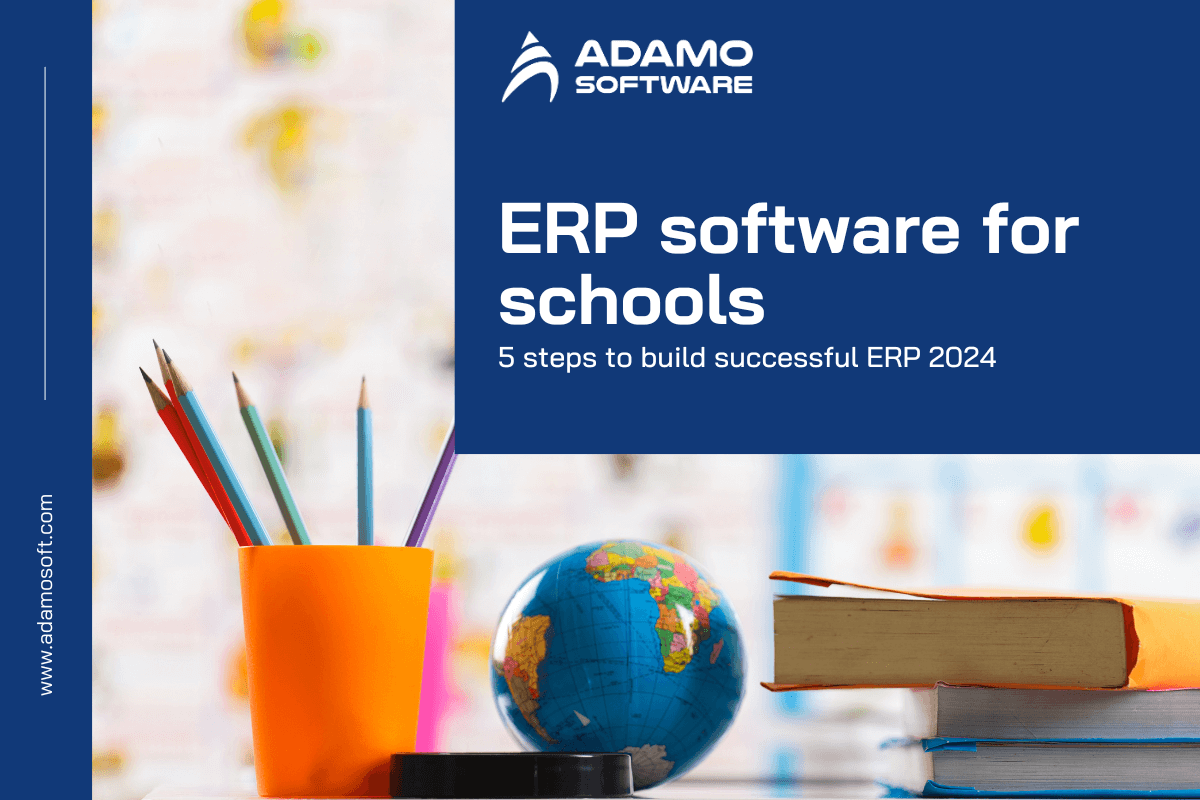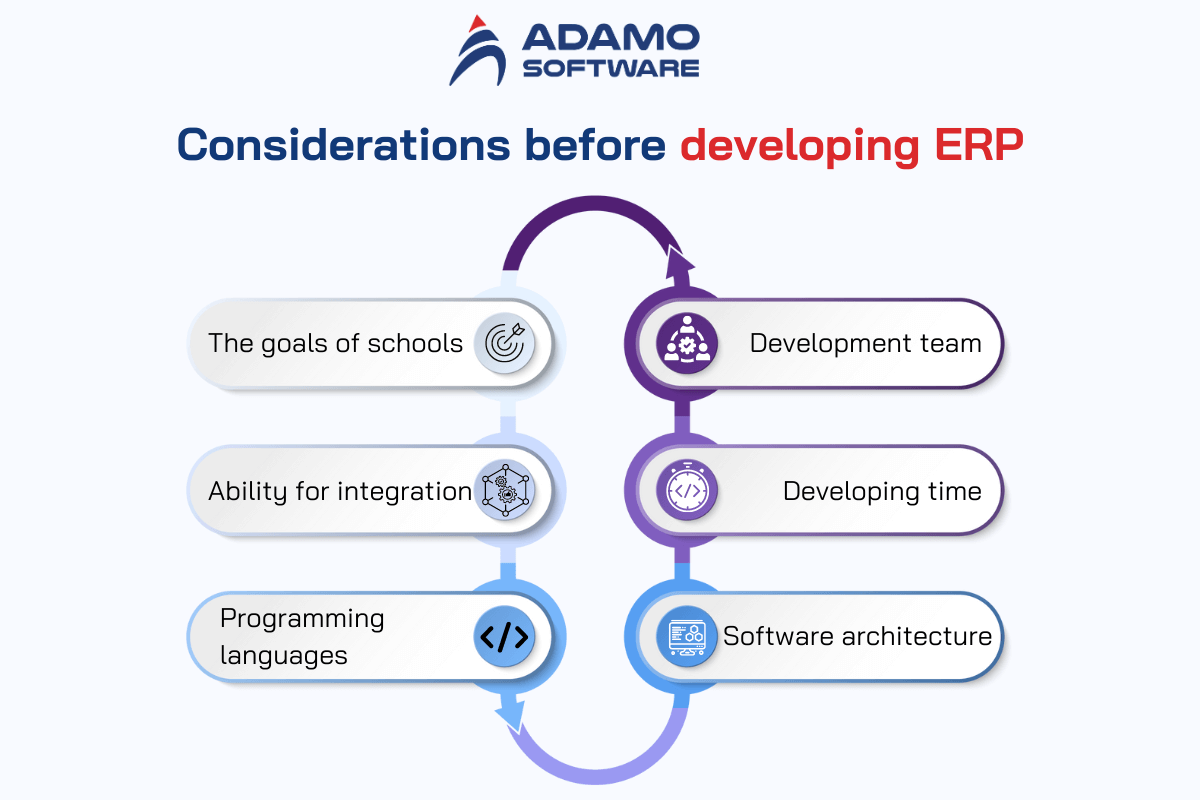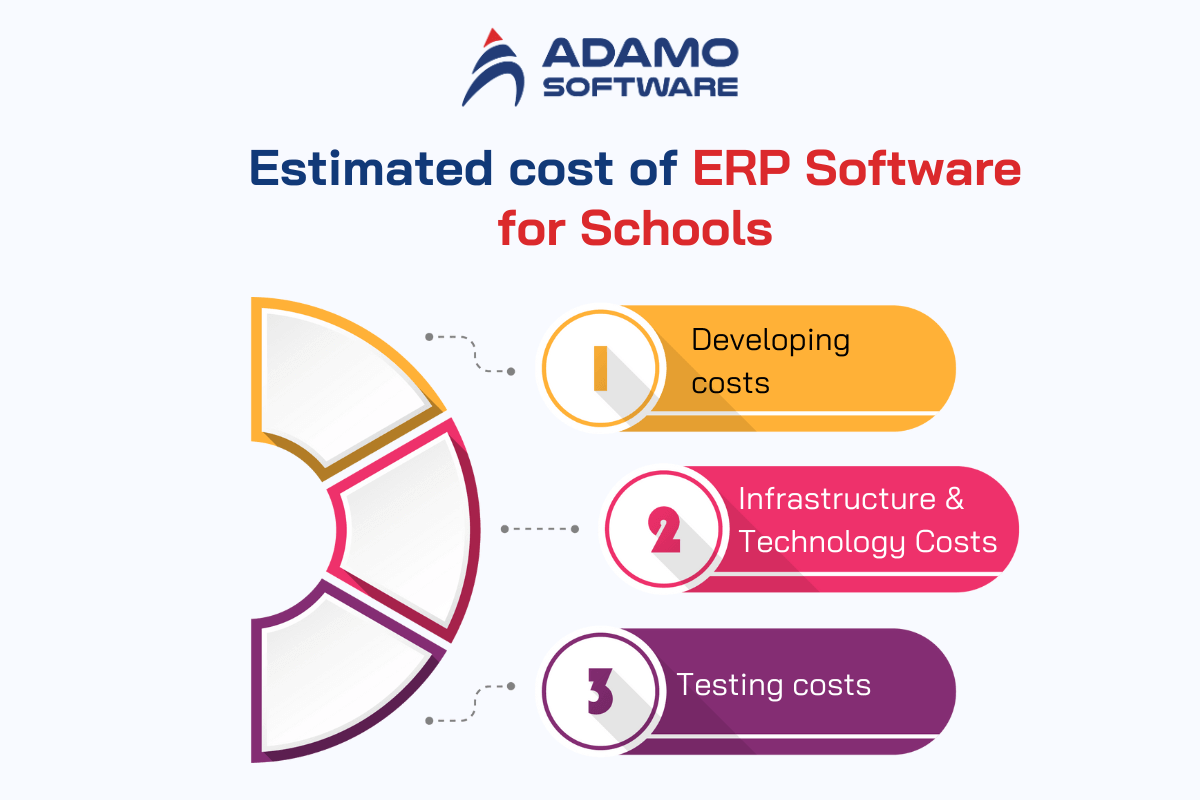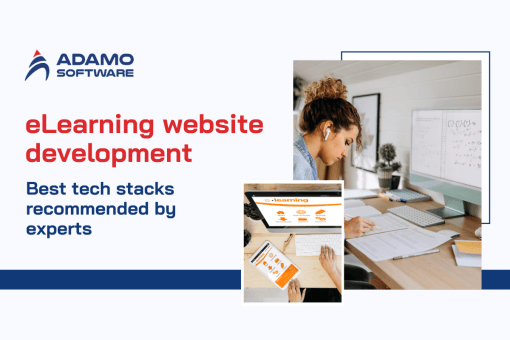5 Steps to Build Successful ERP Software for Schools 2026

In today’s digital age, ERP software has become a useful tool for schools and educational institutions. The ERP software plays an important role in managing a modern, flexible, time-saving, and comprehensively effective education system in this era of globalization. So, what is ERP software for schools? Let’s find detailed information about the ERP school management software with Adamo Software!
Through this blog post, you will have an overview picture of the school management software market. Besides, some considerations before developing an ERP school management system software are also discussed. Additionally, you will also understand thoroughly the essential steps to develop ERP software for schools and the estimated cost to build the software. All information is updated according to trends and carefully researched. Let’s read our post for an overview of ERP software.
I. What is ERP School Management System Software?
Before understanding what ERP software for schools is, you should know about ERP first. ERP, which stands for Enterprise Resource Planning, is an enterprise resource planning system. This is a high-tech management model, applying many modern features to the online management system.
The ERP software for schools is specially designed to optimize management and operational processes in educational organizations. The software aims to provide an integrated platform to manage the data of schools, universities, and training centers while ensuring high privacy and security. Here are some key features included in the software.
- Student information management
The student information system is a process of managing students’ data, learning progress, and behavior. It includes storing, updating, and retrieving data related to student records, grades, timetables, etc.
- Financial management
Financial management is one of the outstanding features of ERP software for schools. With this feature, educational institutions can monitor and coordinate their financial activities. These activities include collecting tuition, managing budgets, expenditures, reserves, and other sources of income.
- Human resources management
Human resources management involves managing and developing a school’s staff, teachers, and employees. ERP software for schools supports educational institutions in recruiting, training, tracking performance, managing salaries and benefits, and implementing human resource policies.
- Managing enrollment and classes
Managing enrollment and classes is also an important feature of the software. It allows schools to automate the process of course registration, class assignment, and scheduling for students and teachers.
Applying ERP software to the education field has promoted traditional education management to develop into smart education with many attractive technologies and features. When using ERP software, schools can integrate and optimize the learning management process. Besides, the manual workload will decrease while work efficiency will be increased thanks to the process’s automation.
Also read: What is a School ERP and Why It is Important for Education
II. Overview of School Management Software Market
The school management software market is globally growing due to the increase in the need for digital education and online learning. Let’s get more insights into the market with Adamo Software.
By the end of 2025, the ERP software for schools’ market is estimated to reach USD 17.25 billion. This figure will continue to increase, reaching USD 33.79 billion by 2029, with a compound annual growth rate of 14.39%. These statistics show the widespread popularity of using software to manage schools’ systems.
North America accounts for a significant share of educational ERP software, which was 36.16% in 2023. It is the scalability, adaptability, and affordability of cloud computing that enhances the region’s market share, making it become the market leader. Whereas the Asia Pacific region is also emerging in the application of software in education. The ERP software for schools’ market is expected to experience a significant rise of 24.77% from 2024 to 2030. India, China, and Australia are the three main countries in the region with the fastest growing.
Key factors driving the growth of educational ERP software include the digitalization of education, technology changes, and government support. Due to the digitalization of education, the demand for distance learning solutions and education management software has increased. Technology is changing every day. With the development of advanced technology like AI, machine learning, and big data analysis, the efficiency and personalization of education software will be improved. Last but not least, many governments are investing in education technology to enhance teaching and learning quality, making ERP software for schools more popular.
In general, educational institutions will continue to use this software due to its benefits. As a result, educational ERP software will see more innovation and expansion.
III. Considerations Before Developing an ERP School Management System Software
If you are having your ERP software for schools developed, you may want to consider many things before starting. Here are some considerations before developing an ERP school management system software.

1. The goals of schools
Before developing your ERP software for schools, you must examine the goals of educational institutions. To thoroughly understand the needs and expectations for the ERP software, you may want to collect information from stakeholders such as administrators, teachers, students, and parents. From that, you can identify the goals that your software needs to achieve. These goals may include improving student management, optimizing finances, enhancing communication, etc.
2. The ability to integrate with existing systems
A school may have various management software. Thus, you must consider the ability to integrate with existing systems of your ERP software. You should know how your app needs to develop to be compatible with the school’s library management software, financial management software, etc.
3. Programming languages and development technology
Programming languages and development technology are two important factors when developing your ERP software for schools. You may want to choose a suitable programming language that fits your software performance, security, and scalability requirements. You can choose Java, Python, C#, and JavaScript. In addition, let’s look at the benefits of using modern technologies for your software. AI, machine learning, and big data analysis are essential to enhance the software’s efficiency.
4. Development team
One person cannot do the whole software development work. Therefore, you should have a development team to develop the software step by step. Complex ERP software for schools needs a team with proficiency in knowledge and software development skills. The team must understand database management, security, and user experience. Besides, the team should have experience working with educational institutions or similar projects so that they can know better about the unique requirements and challenges in this field.
5. Developing time
The development time for your ERP software for schools may normally last from six months to two years, depending on the scale of the project. Before developing the software, you may want to estimate the time from inception until the software is used by the end user. This helps ensure your software development project runs smoothly, meets the schools’ requirements, and is completed on time.
6. Software architecture
Thinking of software architecture before officially starting is essential. This plays a key role in ensuring that the software is efficient, easy to maintain, and can meet current and future requirements. Identifying the software architecture helps to ensure scalability, increase the software’s stability and performance, and provide long-term benefits.
Overall, the above considerations help you develop effective ERP software for schools. So how to create the software successfully? Let’s keep reading for more details.
IV. Complete Guide to Develop ERP Software for Schools
It is not easy to develop ERP software for schools successfully. You may want to follow the steps below to have your software meet your users’ needs and expectations.

1. Generating ideas and initiating the project
Generating ideas and initiating the project is the first and foremost step in building ERP software for schools. This is an important step in deciding the base for your project. Below are some main activities that you should follow in this step.
- Researching and analyzing the market for ERP software for school
Researching and analyzing the market includes assessing the current ERP software solutions to understand their strengths and weaknesses. From this assessment, you can derive your software concept and key features for the software. Besides, this activity also involves identifying the schools’ needs. You may want to analyze what specific needs of the school your software can serve.
- Identifying the goal of your software
You may want to know the main goals of your ERP software for schools. Do you want your software to optimize the student management process? Do you want it to enhance the efficiency of financial management? You may also think of the communication effectiveness among stakeholders and the increase of transparency in school management for your software. Besides the goal, you should define the value the software will bring to the end user, such as saving time, reducing errors in management, or improving user experience.
- Conceptualization
Now, it’s time for you to generate your idea. Let’s list the key features the software needs to have. This may include student management, finances, human resources, classroom management, and reporting.
2. Budgeting and planning
After generating ideas for your ERP software for schools, you will come to the next step: budgeting and planning. In this step, you will identify the needed resources, estimate the costs, and create a detailed plan to ensure the project can be completed on time and within budget. Let Adamo Software discuss more detailed information on some things to do in this step.
- Identifying the budget for your ERP software development project
The cost to develop your app may include personnel, technology, management, and unforeseen costs. The personnel cost includes salaries for software developers, UX/UI designers, project managers, and other specialists. You must ensure that you have enough budget to maintain staff throughout the project development period. When calculating the technology costs, you should consider the costs for necessary technologies such as development software, cloud services, server infrastructure, and testing tools.
Besides personnel and technology costs, management costs must also be focused on. This cost includes project management costs, communication costs, and other operating costs such as office supplies, utilities, and equipment. Additionally, it is essential to budget for unexpected costs during software development.
- Planning
Planning starts with setting a timeline for developing your software. You may want to break down the project into smaller phases and determine how much time each phase will take. Like budgeting, you should plan for extra time for unexpected events or changes. Resources planning involves allocating resources and managing the workload.
3. Developing your ERP software for schools
Finished the planning step? Now, it’s time for you to develop your ERP software for schools. In this step, you will create modules and features based on the requirements and established architecture.
As mentioned, software architecture is among the considerations before developing the software. For developing ERP software for schools, determining the right software architecture is an important factor in ensuring the system is efficient, flexible, and easy to maintain. Good architecture helps shape how the software will be extended and integrated with other systems.
During the development process, close coordination between team members is extremely important. The development team will regularly update the progress and adjust the plan to ensure the project is completed on time.
4. Testing and refinement
Before officially launching your ERP software for schools, you must do testing and refinement. Functional, performance, and security testing are two tests you may want to take. Let’s perform functional testing to ensure that all software features work as expected. Don’t overlook any details when testing.
Besides functional testing, the performance and security of your app also need to be tested. You must ensure the software can handle many users and meets security requirements.
5. Deployment and maintenance
Once you have finished all the steps above, you can come to the deployment and maintenance step. Putting the software into actual use in the school includes software installation, system configuration, and user training for school staff. Providing training to end users and setting up a support system to address issues that arise after deployment is extremely crucial. In addition, don’t forget to perform regular maintenance to ensure the software is always running smoothly.
In general, by following the above steps of developing ERP software for schools, you can ensure that your software meets all user requirements. Besides, management processes in the school can be optimized. Each step plays an important role in creating a quality, easy-to-use, and reliable product.
V. Estimated Cost of Developing ERP Software for School
Depending on the complexity of your project, the estimated costs of developing ERP software for schools can be varied. Here is an estimate of the costs that may arise during the development of ERP software for schools.

1. Developing costs
To develop the software, you must have a development team. The cost of hiring developers, designers, and project managers is different in each region. In regions like North America or Europe, the cost of hiring a programmer can range from USD 50 to USD 150/hour, while in other regions like Asia, the cost can be lower, from USD 20 to USD 70/hour. Besides personnel costs, the costs of developing the user interface and user experience are also significant, which ranges from USD 5,000 to USD 20,000, depending on the level of customization.
2. Infrastructure and Technology Costs
The cost of hosting software on cloud platforms like AWS, Azure, or Google Cloud can range from USD 1,000 to USD 10,000 per year, depending on usage and scalability. If development requires the use of licensed software or tools, this cost needs to be factored in. This can include licenses for third-party development tools, databases, or integrations, which can cost anywhere from USD 5,000 to USD 15,000.
3. Testing costs
Testing is necessary to ensure that the software can handle various users. Below are the costs for functional, performance, security, and user acceptance testing (UAT).
- Functional testing costs
Functional testing includes unit testing, integration testing, system testing, and regression testing. The cost for each test ranges from USD 3,000 to USD 15,000.
- Performance and load testing
If you want your ERP software for schools to run smoothly and meet users’ needs, performance and load testing are needed. The average cost for these two tests is around USD 8,000.
- Security testing
Identify security vulnerabilities in software and ensure user data is kept safe. Security testing can cost from USD 5,000 to USD 15,000.
- UAT
UAT is the last step in the testing process. The cost of UAT can range from USD 3,000 to USD 7,000, depending on the scope of testing and the number of users involved.
In general, the total cost of developing ERP software for schools can range from USD 30,000 to USD 90,000 or even more. This cost is needed to ensure that the software operates securely, and stably, and meets the needs of school users while minimizing the risk of problems arising after implementation.
IV. Build Value-Driven ERP Software with Adamo Software
If you are looking for a unit to help you develop your ERP software for schools, Adamo Software can be your choice. As one of Vietnam’s leading companies in providing technology solutions, we are confident to meet your requirements and expectations. Especially, we are specialized in developing tailored ERP solutions that cater specifically to the needs of educational institutions. Here is how we can help you with your software development.
1. Tailoring the solutions
Not all educational institutions have the same needs. So, we will work closely with you and your team to customize the ERP software, ensuring it aligns with your school’s processes and workflows.
2. Focusing on user experience
Adamo emphasizes designing intuitive, user-friendly interfaces that minimize the learning curve. This ensures that your ERP software for schools can be easy to use for all stakeholders, including administrators, teachers, and students.
3. Ensuring integration and scalability
Adamo Software develops ERP solutions that integrate smoothly with existing systems, such as learning management systems (LMS), financial software, and HR systems. Besides, we can scale your software to accommodate more users, additional data, and expanded functionalities.
4. Ongoing support and maintenance
Even when your software has been launched, we still support you when needed. We will provide ongoing support and maintenance, ensuring the software remains up-to-date with the latest technological advancements and educational requirements.

Do you still hesitate to choose Adamo Software for your ERP software for schools? Don’t worry, we guarantee the quality of our service.











